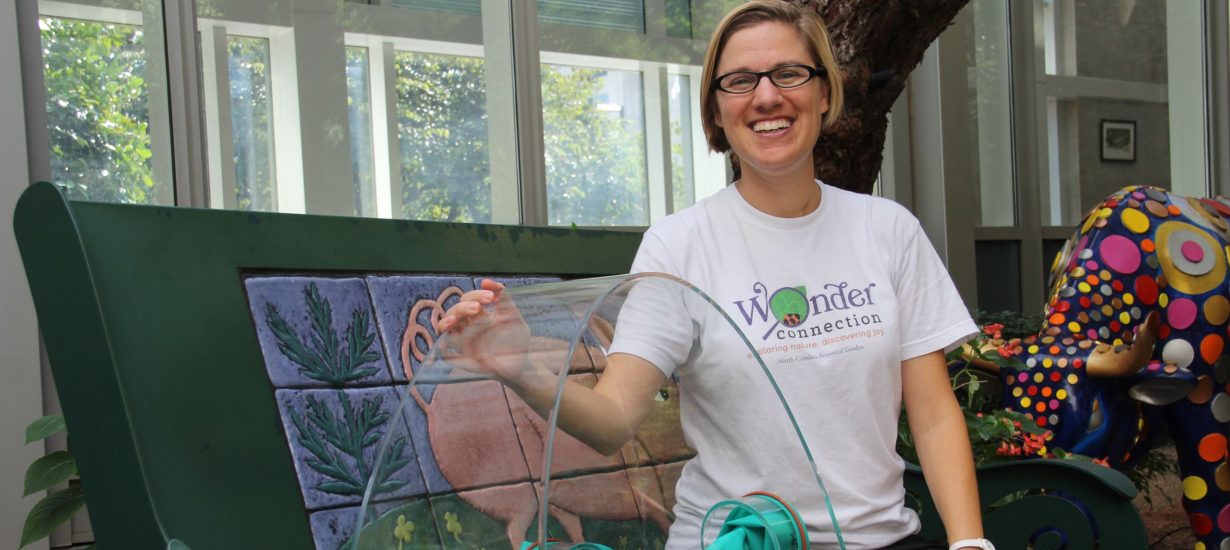The Patients and Nature Meet, Inside the Bubble

Hordes of butterflies dance around blooming flowers to the beat of the buzzing cicadas. A firefly light show floods the spaces between trees. An unlucky ant meanders into the jaws of a Venus fly trap. There’s nothing more beautiful, or alive, than the N.C. Botanical Garden in summer — but not everyone gets to experience its wonders. Katie Stoudemire is changing that.
Stoudemire leads the garden’s Wonder Connection program, which brings native North Carolina plants to kids at the UNC Children’s Hospital. She often can be found at the UNC Hospital School, which provides year-round preK-12 educational services to school-age patients. While some young patients visit the school to conduct science experiments, others can’t even leave their rooms for fear of compromising their immune systems.
After observing the beds in the neonatal intensive care unit one day, Stoudemire wondered: “What if, instead of putting the kid in the bubble, we could put the plant in a bubble?” From that, she developed the concept for the WonderSphere — a sealed, mobile chamber with built-in gloves that enables hospitalized children to touch nature without danger of infection.
After receiving two $25,000 grants — one from the North Carolina GlaxoSmithKline Foundation and another from the Institute of Museum and Library Services — Stoudemire worked with the product design firm Bresslergroup to build the WonderSphere. The result was a clear dome that rests on a base surrounded by clasps to keep it sealed. Three portals feature built-in gloves — two for the child and one for a parent or sibling to assist the child.
“We set the dome on their hospital tray, and then they’re able to slip their hands in and interact with a variety of objects,” Stoudemire explained. “We give them a magnifying glass, and there’s also a little tray inside that rotates so they can move things around easily.” Kids have the option to observe Venus fly traps and caterpillars, dissect pitcher plants and make flower arrangements.
Last May, the WonderSphere won an award given annually to projects that benefit social, humanitarian, community or environmental causes. “It’s great to have professional validation,” Stoudemire said, “but really the biggest reward is watching a kid get to use it.”
The next iteration of the WonderSphere is Hippoie Creek — a miniature creek exhibit that sits atop a mobile hospital cart. The reproduction is layered with epoxy to prevent bacteria growth and uses recirculated water filtered to the specifications of the hospital’s epidemiology department. Kids can play with individual rocks within the creek to divert the flow of the water, as well as replicas of aquatic insects to learn about water-body ecosystems.
“Magnets on the bottom of some of the rocks will hold the insects in place,” Stoudemire said. “We can use these tools to conduct a bioindicator stream study with middle- and high-school students. The bugs in a stream can tell scientists a lot about a creek’s ecological health.”
The creek inherited its name from a stuffed animal named “Hippoie,” which belonged to a former patient of Stoudemire’s.
“Hippoie got lost in the hospital laundry — which is scary, because when toys get into the laundry here they rarely make it back to their owners. Well, Hippoie came back. I really like the concept of finding something you’ve lost. A lot of the kids here have lost touch with nature, and I want to help them find it again.”
— Alyssa LaFaro
Alyssa LaFaro is editor of Endeavors, UNC’s online research magazine, where this article first appeared. The magazine is at endeavors.unc.edu.
